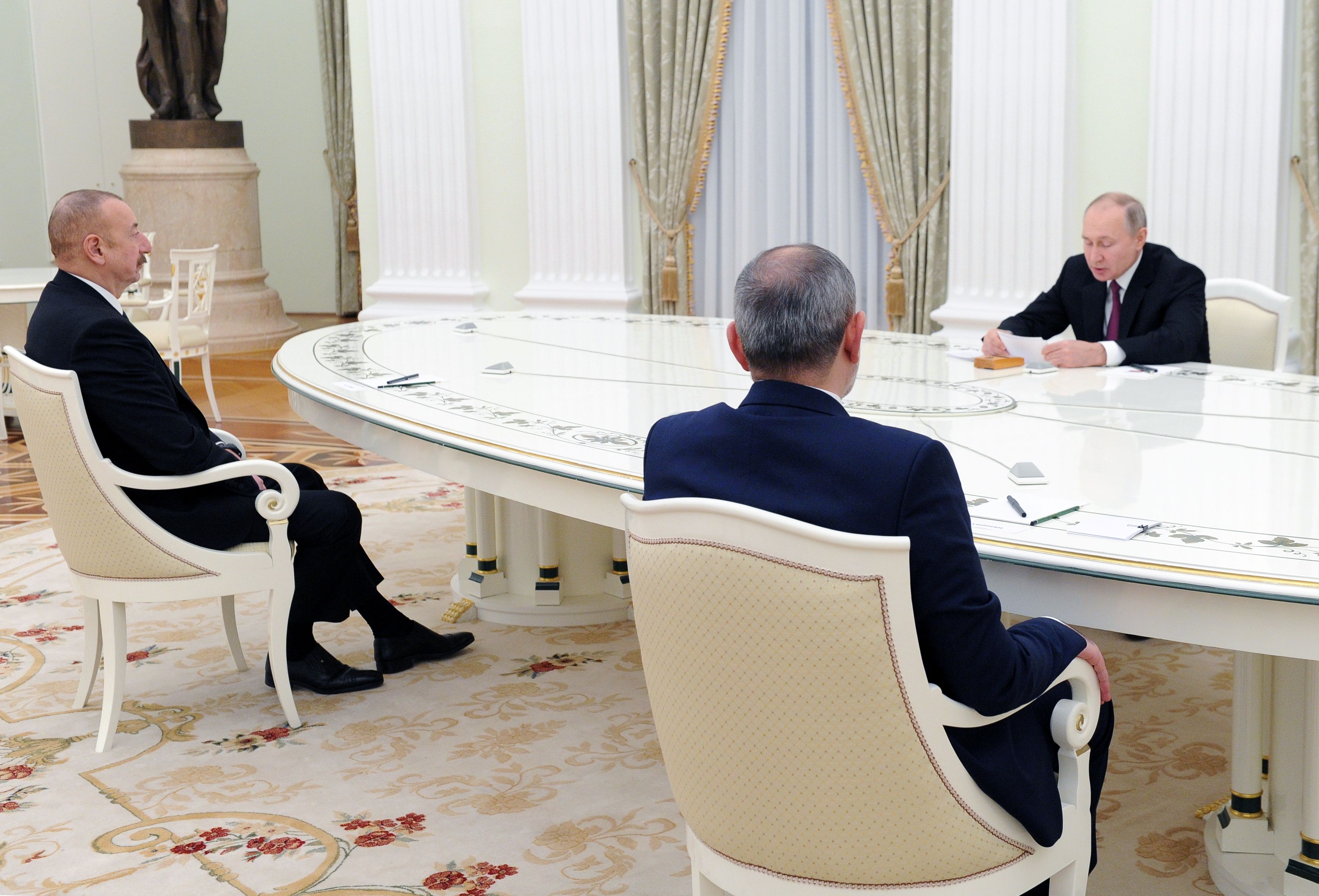Russia’s Peacekeeping Operation in Nagorno-Karabakh: Goals and Challenges

The agreement between Azerbaijan and Armenia, signed under the auspices of Russia on 9 November 2020, ended the 44-day military operation in NK and other areas occupied by the Armenians outside the disputed region. Oversight of the implementation of the agreement was entrusted to Russian peacekeeping forces deployed on the territory of NK and the Lachin Corridor. The core of the peace contingent consists of units of the 15th Separate Motorised Rifle Brigade from the Central Military District with a total of 1,960 troops. Their task is to clear the area, assist in the return of refugees, and monitor the implementation of the ceasefire by the parties to the conflict.
Russia’s Goals in NK
The ceasefire agreement was intended to ensure that Russia would maintain its influence in the South Caucasus by introducing Russian peacekeeping forces into NK. Russia had been striving for this for almost 30 years in cooperation with the U.S. and France within the OSCE Minsk Group, but it was unable to force the consent of both sides of the conflict. Russian Foreign Minister Sergey Lavrov, during the previous escalation in NK in 2016, proposed restoring Azerbaijan’s control over part of the territories occupied by Armenians and introducing Russian peacekeeping forces there. Only now has it been possible to implement these proposals: for the first time, Russia has deployed troops on the territory of NK, that is, on the territory of Azerbaijan. In addition, as a result of the military operations, the Armenians lost control of large areas and became even more dependent on Russian military aid. At the same time, Russia became the sole guarantor of Armenians’ security in NK, although the Russian authorities did not manage to negotiate a special status for them. However, during the meeting in Moscow, the issues of transport routes from Russia via Azerbaijan to Armenia were discussed, which would further strengthen the position of the former in the South Caucasus region.
At the same time, Russia has dominated the negotiations around NK and marginalised the remaining participants of the Minsk Group. During the recent escalation, France and the U.S. indicated that they had not been informed by Russia about the ceasefire agreement. Neither were the countries able to pressure Azerbaijan to stop fighting. As a result, they called on Armenia and Azerbaijan to implement the agreement negotiated by Russia.
Another goal of Russia is to weaken the Azerbaijani-Turkish political alliance and Turkey’s growing ambitions in the region. The Turkish side declared its willingness to participate in the peace mission, but the Russian authorities only agreed to establish a joint observation centre in Azerbaijan. The location of the centre was also a problem, as Turkey wanted it to be placed in the territories regained by Azerbaijan in order to influence the course of the peace process. Additionally, Turkey is interested in building a railway connection with Azerbaijan via Armenia, which would deepen its cooperation with the Azerbaijani side.
Russian Peacekeeping Missions in Practice
Russia has already deployed forces to countries where armed conflicts took place in the past (including Moldova, Georgia, and Tajikistan). It uses these forces to try to maintain influence on the situation after the end of the active phase of military operations and at the same time block any possible entry of the particular countries (e.g., Georgia) from entering Euro-Atlantic structures. The Russian missions deviate from the practice of UN peacekeeping operations. The Russian authorities do not strive to ensure a multinational contingent nor neutrality and they have engaged the parties to the conflict.
The first peace missions in 1992 consisted of the formation of mixed control commissions, composed of Russians and representatives of the warring parties (e.g., Ossetians and Georgians, Transnistrians and Moldovans). Although in Abkhazia (1994) and Tajikistan (1997), Russia tried to internationalise peacekeeping operations by involving troops from the Commonwealth of Independent States, it ended in failure because, at a later stage, it was mainly Russians who participated in the missions (e.g., in the mission in Tajikistan, Russians constituted 93% of the contingent). On the other hand, the Russian authorities compensated for the lack of an international character to the mission with UN and OSCE observers, sent to Abkhazia and South Ossetia, respectively. Russia’s fascination with this unique kind of peacekeeping and idea of neutrality was confirmed in August 2008 when Russia attacked Georgia from the territory of South Ossetia, arguing that it was carrying out a “peace enforcement” operation. After the Russo-Georgian war, both observation missions (in Abkhazia and South Ossetia) were terminated by the authorities of these entities.
The Russian peacekeeping mission in NK can be compared to peacekeeping operations conducted under the aegis of the United Nations. In NK, the forces were introduced for a limited period (five years, with the possibility of extensions) and after a ceasefire was achieved and accepted by both sides (Azerbaijan and Armenia). However, doubts remain about its neutrality and the lack of international control, as expressed, for example, by the OSCE.
Challenges and Prospects for Russia in NK
The assumption of the main responsibility by Russia for the situation in NK creates opportunities but also challenges for its influence on the countries of the South Caucasus. As the peace operation in NK is the first purely Russian mission, it poses challenges to the security of Russian military personnel. To avoid provocations and attacks on the Russian contingent, they have established cooperation with the general staffs of the armed forces of Azerbaijan and Armenia. At the same time, to minimise criticism at home about the participation of Russian soldiers in this foreign conflict, only professional soldiers with experience in Syria were sent on the peacekeeping mission. Although the agreement may be terminated after five years (e.g., by Azerbaijan), it is doubtful that the Russian forces will withdraw from NK without guaranteeing Russia’s superior position in the region.
The ceasefire in NK does not end the conflict between Armenia and Azerbaijan. The Russian peacekeeping operations to date have contributed to freezing and prolonging conflicts rather than resolving them. In the ceasefire agreement, the parties did not define the final status of NK, which would have caused further tensions between Azerbaijan and Armenia. Russian diplomacy will face the challenge of finally resolving the growing Armenian-Azerbaijani disputes. Azerbaijan has not given up on regaining all of NK, and the success of its latest military operation likely has only encouraged the authorities to adopt military solutions. Azerbaijan’s stubbornness on this goal remains a problem for Russia, so it will try to put pressure on the former to discourage offensive actions (for example, in December last year, Russia introduced an embargo on Azeri agricultural products).
Russia’s domination of the talks on NK will limit the activity of the OSCE Minsk Group and hinder the possible involvement of the EU in settling the conflict. Russia will be reluctant to give up the initiative in the peace talks, although in the event of difficulties in the implementation of the mission, it may seek political support from the UN or the OSCE.
The Russian authorities will not stop Turkey from providing military aid to Azerbaijan and it will be difficult for it to block all Turkish support, such as observers, military equipment, or the construction of infrastructure connections between these countries. As a result, NK is another conflict like Syria or Libya in which Russia and Turkey will indirectly act against each other. This will hamper NATO’s activities in the South Caucasus, both in its contact with countries outside the alliance, including Georgia and Russia, and on the Alliance’s crisis management.


